Amyotrophic Lateral Sclerosis(ALS): A day without the Muscles.
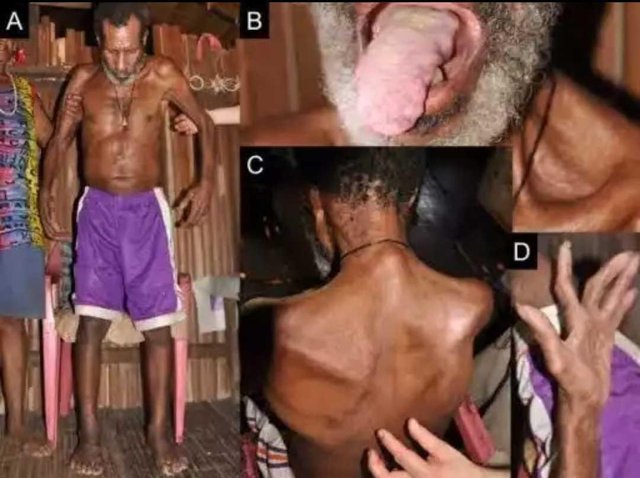
A neurodegenerative disease patient. Credit: wikimedia CC3.0 license.
The #Voiceyourlove campaign saw two prominent blockchain and cryptocurrency communities show an amazing philanthropy towards the ALS association with the Tron(Trx) society’s founder Justin Sun pledging a $250,000 donation to the association to aid assistance to individuals living with the dysfunction; and Binance, one of the largest cryptocurrency exchange in terms of 24hrs trading volume also pledging $150,000 to the association.
With this condition gaining prevalence over the years and slowly moving from rare to a relatively popular condition as the ratio of affected to unaffected individuals closes in gradually and hence the the increasing popularity of this condition.
A day without the muscles, sounds a bit euphemistic and a bit far from what this condition actually represents, yet sounds strange and most people will prefer a more explicit tag such as a lifetime without the muscles which better explains the condition and is even scarier.
The Condition
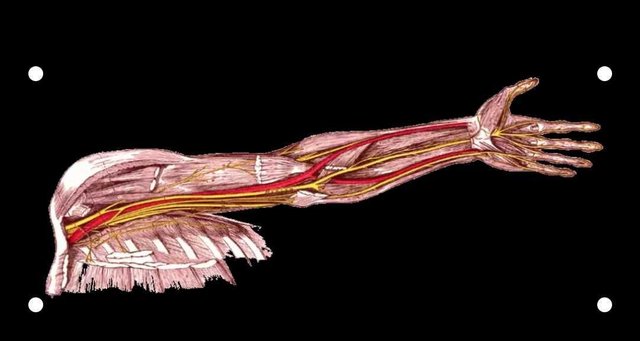
innervation of the muscles of the arm by the spinal nerves. Credit: wikimedia CC3.0 license.
The muscular system is rather a collection of soft tissues and fibres than its physical appearance of strong and rigid build capable of outperforming some heavy-duty machines in terms of accuracy and range of applications. Probably fans of the popular game of thrones movie will be familiar with George Clegane (The mountain), fans of WWE are unarguably familiar with Mac Henry and a host of other strong men whose muscular power could be compared with that of machines. Far from these extremes, our individual muscles are very important part of us, every activity, from kicking the soccer ball to external respiration and even the cardiac activities which keeps us alive are all dependent on our muscles with variations in these types of muscles enabling them perform these different tasks.
While the cardiac and smooth muscles which controls the hearth function and the respiration (internal and external) process respectively are involuntary and functions spontaneously –independent of our willingness, the skeletal muscles are voluntary and only function when we want them to do so and hence are under the voluntary control of the somatic nervous system, functioning only when the body is willing to respond to stimulus which triggers their actions. The afferent nerves of the somatic nervous system relays the sensation from the body to the Central nervous system where these impulses are integrated and relayed to the efferent nerves which sends these impulses to the body, stimulating muscular contractions and/or relaxation with the spinal nerves accounting from most voluntary actions.
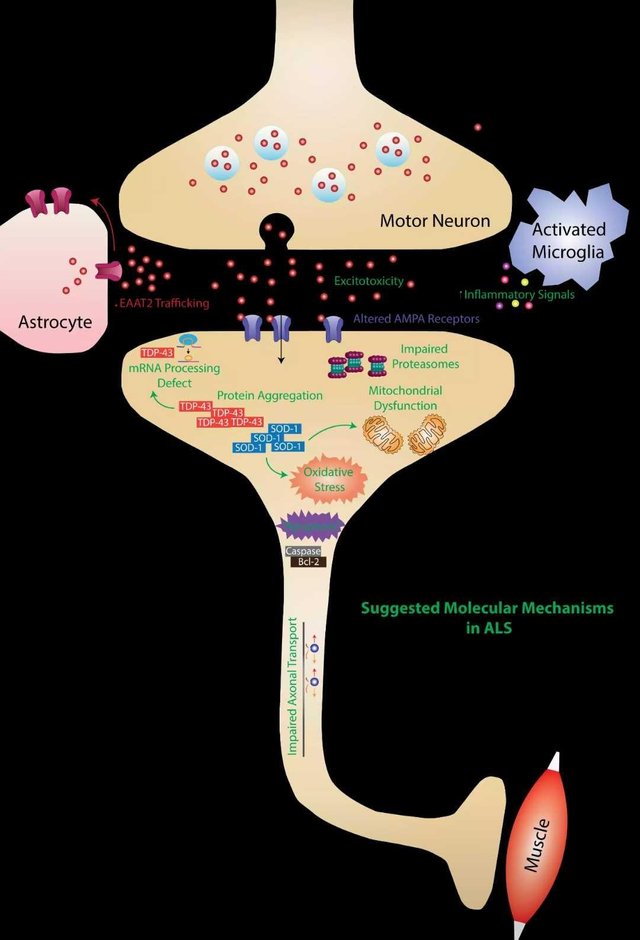
Suspected mechanism of action of Amyotrophic Lateral sclerosis. Credit: wikimedia CC3.0 license.
Amyotrophic Lateral Sclerosis (ALS) also known as Lou Gehrig’s disease results from the atrophy of these neurons controlling the actions of the skeletal muscles, starting off as just a common muscle cramps and spasms, this condition worsens over time and gradually develops into worse symptoms such as muscle weakness and atrophy of the muscle with the muscle size reducing gradually and thus getting less functional and routine muscular activities such as walking, talking and chewing are impaired and as the condition progresses, these impairments gets worse and patients might find it hard to swallowed chewed foods.
The Pathology
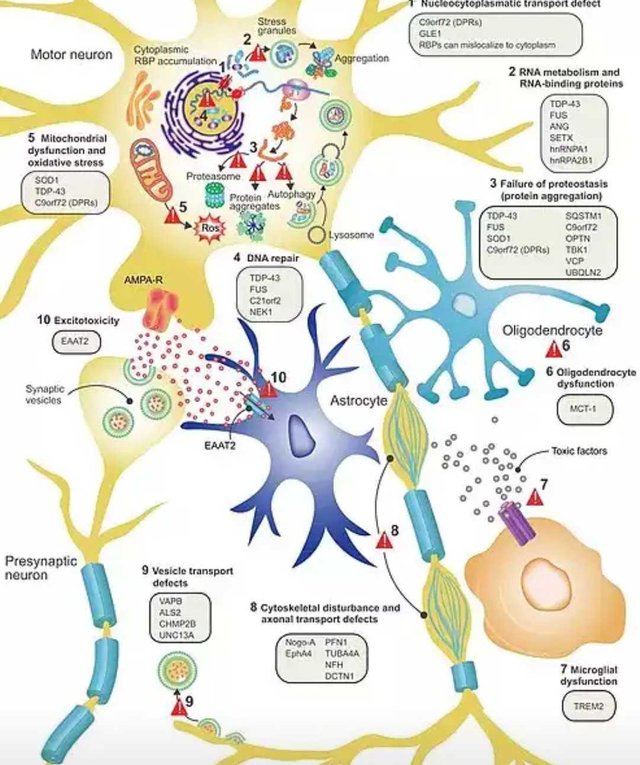
Proposed pathology of AlS. Credit: wikimedia CC3.0 license.
Despite having an age dependent rate of occurrence, several risk factors can expose one to Amyotrophic Lateral Sclerosis at early age of 6–18 years, however people of higher age (19 and above) are more vulnerable to this condition with men more likely to be affected than women the Caucasians are the most vulnerable race. The degeneration of both the lower and upper motor neurons results in the impairment of muscular activities as the transport of impulses from the afferent and efferent neurons are altered, starting off with mere muscle cramps and progressing over time to affect other muscular activities including speech, patients are fatigued as muscle weakness sets in, the Condition also progresses to the smooth muscles, affecting the gastrointestinal functions leading to severe constipation, muscles are smooth and muscle atrophy causes the muscles to reduce in size, this is due to lack of use of the muscle and inability to exercise them.
An infection or a dysfunction
With the origin of Amyotrophic Lateral Sclerosis remaining almost as mysterious as it’s cure; the activities leading to the development of this condition have been a puzzle, while previous researches have been unable to point out a microbial infection or a viral attack, other leads have also been blurry, however, with the increasing proofs of the absence of microbial or viral involvement in this condition, Amyotrophic Lateral Sclerosis is more of a dysfunction than an infection, while no definite cause have been named, the following could expose an individual to this condition:

People who engage in physical activities such as American football have been shown to have more risks of neurodegenerative diseases such as ALS. Credit: wikimedia CC3.0 license.
Head Injury?: Yes, a question mark had to some after this factor, while many researches have attempted to rule out the possibility of poorly managed head injuries to cause Amyotrophic Lateral Sclerosis due to the inability of previous attempts to distinguish/state the degree of head injuries which could lead to this condition; head injuries unarguably has a role to play in either aiding the development of ALS or at the extreme, being a major risk factor in the development of ALS. This is due to the fact that many victims of this dysfunction either have a head injury history or are known to engage in much physical activities either as a hobby, as a career or both as the case may be; the chances of developing mild injuries due to falls during these activities exists, however, these injuries are neglected most times as they show no reasonable symptoms, however, further falls and accumulation of these repeated injuries and the resultant progression of these brain injuries could at least aid the development of ALS, this is also evidence in the fact that sports such as Soccer and American football have been identified as risk factors for ALS in several researches with some NFL players dying from neurodegenerative diseases including ALS.
Gene Mutation: Mutation in an individual’s genes have also been identified to be a principal cause of ALS and genetic inheritance being the most understood cause of Amyotrophic Lateral Sclerosis. Mutation in at least two of the over twenty genes associated with ALS leads to the development of the condition, relatives of an individual with ALS stands about 1% chances of also developing the condition with research into the family history of patients of ALS with repeated expansion of the C90rf72 genes accounting for about 40% of the genetically acquired ALS and the aggregation of TDP-43 proteins seen in about 97% of individuals with ALS.
Lifestyle and Environmental factors: Hardly have there been any systemic dysfunction or disease without a correlation with one’s environment, race and lifestyle. Environmental toxins emanating from pesticides and serum uric acid such as dielderin, DDT, and toxophenes, exposure to very low frequency magnetic fields and heavy metals and lifestyle such as smoking and consumption of omega-three fatty acids (tentative) and occupations such as farming and Military services have all been shown to expo
A Solution
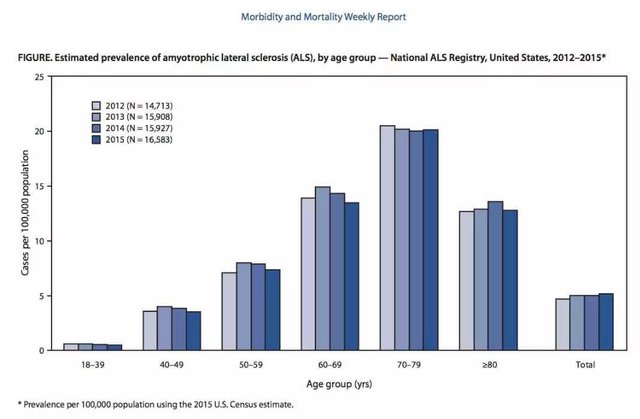
a graphical representation of the Prevalence of ALS in the United States by age. Credit: wikimedia CC3.0 license.
Sadly none, supportive care and management remains the only option with attempts centred towards sustaining the patient, this can be done via the administration of a glutamate blocker to inhibit the excitatory action of glutamate and reduce the muscle excitation and also a muscle relaxant to help reduce muscle tension and relieve the pain and discomfort.
Using breathing and feeding aids also helps to sustain the patient by ensuring that internal and external respiration continues despite the inactivity of the muscles, the patient should also be assisted to exercise the muscles and reduce the risk of atrophy.
Preventive measures are only suggestive as the causes are still obscured, however, precautions such as keeping the head as safe as possible during sports and physical activities and routine check up on the brain to ensure optimal functioning is advised.
Not just a day without the muscles, more like a lifetime without the muscles, but even though life expectancy is about 2-5years, good management can prolong the life span of the patient.
References
Amyotrophic Lateral sclerosis (ALS) fact sheet
Amyotrophic Lateral Sclerosis~wikipedia
somatic nervous system ~Wikipedia
Amyotrophic lateral sclerosis~raredisease database
If you write STEM (Science, Technology, Engineering, and Mathematics) related posts, consider joining #steemSTEM on steemit chat or discord here. If you are from Nigeria, you may want to include the #stemng tag in your post. You can visit this blog by @stemng for more details. You can also check this blog post by @steemstem here and this guidelines here for help on how to be a member of @steemstem. Please also check this blog post from @steemstem on proper use of images devoid of copyright issues here.

This disease and that rugby player disease the movie Concussion was based on are at par in terms of how debilitating it could get.
Yes, we underate those falls and the little internal injuries that comes with them, sad enough they are more lethal than the external injuries we sustain.
Interesting and well-written article. I am not sure I've come across ALS before now. Is this peculiar to a particular race? It would be interesting to see a pattern of distribution of the disease globally if that will not be too much to ask for.
No, it isn't race specific, however some races are more vulnerable particularly the Caucasians, but it is not limited to this race only. I'll try and get a sketch of the global distribution surely it wouldn't be so hard to find.
Here's an extract from a research to determine the Racial and Ethnic Differences across Amyotrophic Lateral Sclerosis (ALS) Cases from Three State and Eight Metropolitan Area Surveillance Projects.
More details can be found here,
Hello! I find your post valuable for the wafrica community! Thanks for the great post! We encourage and support quality contents and projects from the West African region.
Do you have a suggestion, concern or want to appear as a guest author on WAfrica, join our discord server and discuss with a member of our curation team.
Don't forget to join us every Sunday by 20:30GMT for our Sunday WAFRO party on our discord channel. Thank you.
This post has been voted on by the SteemSTEM curation team and voting trail in collaboration with @utopian-io and @curie.
If you appreciate the work we are doing then consider voting all three projects for witness by selecting stem.witness, utopian-io and curie!
For additional information please join us on the SteemSTEM discord and to get to know the rest of the community!